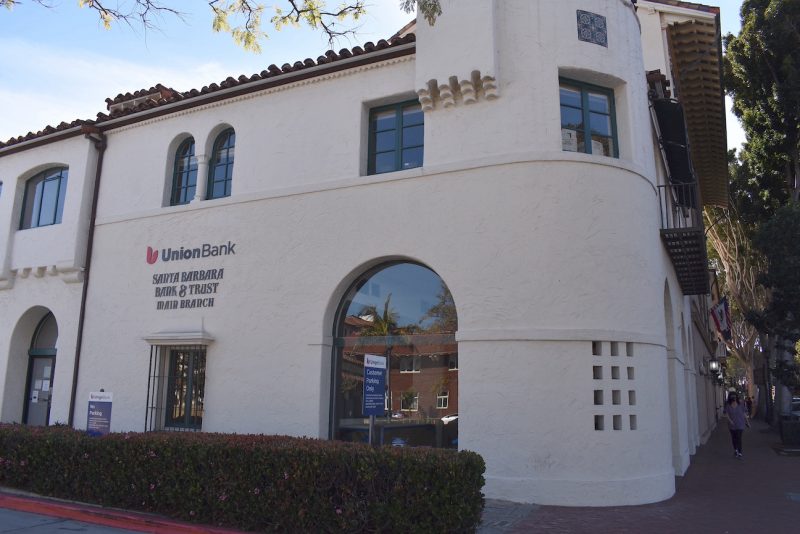
Cari Shore, a senior vice president and director of community banking at Montecito Bank & Trust, started working in the banking industry 30 years ago. Since then, she said, there has been constant noise about brick-and-mortar bank branches becoming obsolete or technology taking over.
“For important life events, people still want to walk into a branch,” Shore said. “That human element is still going to be critically important.”
But some bank branches have closed for good across the tri-county region in recent years, according to a Business Times analysis of data released by the Federal Deposit Insurance Corp., online research and email surveys.
San Francisco-based Wells Fargo, for example, had 49 branches in late September 2020 and 45 open as of Dec. 31, 2021. New York-based JPMorgan Chase Bank downsized from 48 branches to 44 in that time.
Last year, Sierra Bancorp, the parent company of Bank of the Sierra, closed five branches, including two in San Luis Obispo County. The Porterville-based bank’s branches in Atascadero and Arroyo Grande closed in June 2021. The bank said it planned to shut branches that were located “outside of the bank’s primary market area” and found in-person transaction volumes no longer warranted a traditional brick-and-mortar branch.
A Wells Fargo branch near the intersection of north Milpas and Mason streets in Santa Barbara has a sign on the front door that says, “This branch is temporarily closed.” In a written statement to the Business Times, Josefina Talavera, a Wells Fargo spokesperson, said branches continue to play an important role in the way the bank serves its customers, and “as customer preferences change, so will our branches and the experiences customers have in them.”
“Most of our branches remain open and our temporarily closed locations will resume operations as soon as possible,” Talavera said.
A new report from S&P Global Market Intelligence, released in January, highlights the national trend of banks closing physical branches. Nearly 270 banks closed their doors in California last year, more than in any other state, the report found. Michigan had 247 closures, followed by 221 in New York.
The S&P Global analysis shows United States banks opened more than 1,000 branches and closed nearly 4,000 branches in 2021. On net, accounting for openings and closings, U.S. banks shuttered 2,927 branches, according to S&P Global data.
In 2020, U.S. banks “set a new record for shuttering” retail branches as more consumers turn to digital banking in wake of the COVID-19 pandemic. Banks “shattered that record” in 2021, with U.S. bank retail branch closures rising by nearly 40%.
Wells Fargo reported the most net closures in 2021 at 267, followed by U.S. Bancorp with 257 net closures.
“Banks have accelerated plans to consolidate their branch footprints as the COVID-19 pandemic encouraged consumer adoption of mobile and digital channels,” S&P Global’s Zach Fox and Umer Khan wrote in the report. “Further, banks have faced a tough operating environment, with low interest rates pressuring margins and forcing a reconsideration of expenses.”
At Montecito Bank & Trust, which has 11 branches in Ventura and Santa Barbara counties, branches are “still very important and still very much part of who we are because being inside of the community is an intrinsic value,” said George Leis, the bank’s president and chief operating officer.
“While it’s true transaction volumes are declining in our branches, while it’s true our national bank competitors are consolidating offices — I can tell you with 100% certainty, customer service matters,” he said.
In 2020, Montecito Bank & Trust opened a 2,600-square-foot full-service branch on Cliff Drive on the Mesa in Santa Barbara.
The “older” banking model was larger branches, between 3,000 and 6,000 square feet, with tellers and other services under one roof in a prime retail location, said Michael Martz, a founding partner and owners of Hayes Commercial Group.
“We’re seeing more of a reduction in footprint for retail branches,” Martz said.
In the city of Santa Barbara, a drive-through window can be a unique selling point for a bank location. Martz said the city doesn’t allow new drive-through facilities, so if a bank leaves a location that features a drive-through, usually another bank will jump on the chance to move in.
“It’s gold,” Martz said of a drive-through.
Another big trend in the banking industry is consolidation, such as U.S. Bancorp purchasing MUFG Union Bank for about $8 billion. The deal was announced in September and is still pending.
In a deal like that, Martz said, it’s common for the new combined company to close some of its branches.
Joanne Funari, executive vice president and chief operating officer of Santa Barbara-based American Riviera Bank, said the banking industry has evolved and “everybody needs something different at different times,” which means demand for both online and in-person services.
In general, she said, community banks can get by without the three, four or five branches in every city that a national banking company might have.
“They don’t need to have a building or space on every corner,” Funari said. “A lot of business is done through relationships.”
In the future, Funari sees more banks partnering with retail. For example, Funari said a bank might have a coffee area or coffee shop and Wi-Fi for customers.
“You go to the bank, but you can hang out,” she said.
